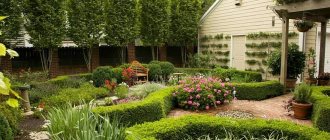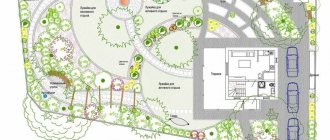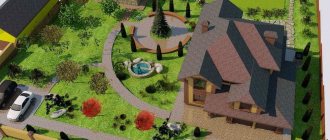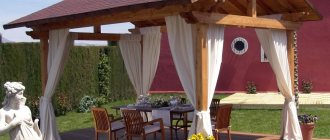Garden beds are gradually being replaced from dachas and garden plots. If they exist, they are in small quantities and somewhere in the depths. The main place is occupied by flower beds, recreation areas and other beautiful corners. All this together is called landscape design and is taught at the institute. But if you don’t intend to make money by arranging, landscaping and decorating courtyards and dachas, you can try to plan everything yourself. Landscaping with your own hands is a long and difficult task, but extremely exciting: it is very pleasant to look at the beauty created with your own hands.
Where to begin
As always, you need to start with a plan. You can draw it on graph paper to scale, or you can use design programs. The most convenient are Realtime Landscaping Architect and Sierra Land Designer 3D 7.0. In them, all the images will be three-dimensional and you will really be able to evaluate how your site will look. And let few people strictly adhere to the plan. But while you are drawing, you will develop certain skills in landscape design that will help you in bringing your plans to life.
Rectangular plot: landscape design plan
If the site is still empty, you think through all the little things: where the entrance will be, how the house, toilet, and other buildings will be located on the site. After drawing all the buildings, draw the paths. Direct ones are rarely done - they are harder to beat in the landscape. Curved, with smooth lines will help organize interesting places and plantings. On the plan, do not forget about communications - water supply, sewerage, irrigation system, etc. Then gradually add landscape design elements, drawing out their details.

Landscape design plan for a square plot of a country house
If you are equipping an already inhabited dacha or yard, apply everything that already exists as accurately as possible. To do this, you will have to crawl around the site with a tape measure: first sketch out a plan of the site and write down the measured distances on it. Then the plan will have to be adjusted based on the measurement results. You got the plan that you have. It will have to be worked on.
Try to immediately draw the changes you have planned, because you have something in mind. If you like the result, you can implement it. If not, first change the shape, or figure out where you can move it to make it look better. That’s why it’s more convenient to work with programs: you see what needs to be changed and how these changes affect the design of the site.
Just one moment. Not everything that looks good on screen also looks good in real life. And it happens the other way around - it doesn’t look “very good” in plan, but what is brought to life is simply mesmerizing. In any case, you will have to make adjustments more than once...
Landscape Design Rules
The main task of site design is to create a harmonious landscape. If so, then we have to take into account the basic laws and observe proportions. One of the main laws that is used when developing any design, including landscape design, is the law of the triangle or the golden ratio.
When applied to our case, it can be interpreted as follows: in order for the plantings to look beautiful, they cannot contain the same elements. For example, dividing a flower bed into zones. Often three different sections are distinguished, but you shouldn’t make them the same size: one is the largest and two are smaller, but also of different sizes. Also, one color should be the main color, the other two should be additional. Moreover, one of the additional ones is generally in small quantities. This also applies to the choice of plants, both their color and shape and size.
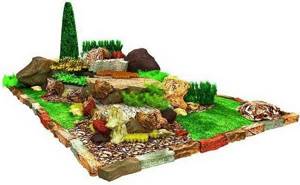
Site design planning taking into account the laws of landscape design
This rule applies not only to flower beds and flower beds, but also to design in general: the number and size of zones on the site, the design of paths, etc.
When creating landscape design with your own hands, you must adhere to the law of the circle. It determines harmonious color combinations (see photo). If you divide it in half with a vertical line, warm shades will be on the right, cool shades on the left. The main compositions are composed of one group of colors - cold or warm.
This does not mean that colors from different parts cannot be mixed. It is possible, but a color from the opposite group should be present as an accent that attracts attention. Such contrasting compositions are made if it is necessary to divert attention from something (fence, toilet, etc.).
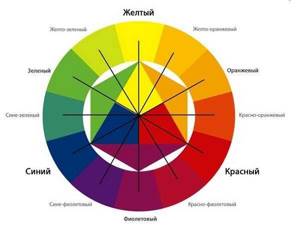
The color wheel is used to determine related color palettes
There is also the law of the square. In a small dacha or courtyard it is difficult to adhere to it, but it influences the rules for the location of buildings and the planting of plants. Its essence is in orientation to the cardinal direction. For example, when choosing a place for a house, remember that if you place it on the south side, almost the entire area will be in the shade. In some regions this is good, in others it is bad. You decide for yourself.
The position in relation to parts of the world is also taken into account when planning recreation areas. For example, it is better to make a pool on the south side: the water should warm up. But nearby there should be a shaded area, a canopy, a pergola in which you can rest from the hot sun.
In relation to planting plants and determining a place for a garden, it can be interpreted as follows: the tallest plants should be located in the north (if you do not live in the south and you do not need shade). Then the rest of the space will be well lit.
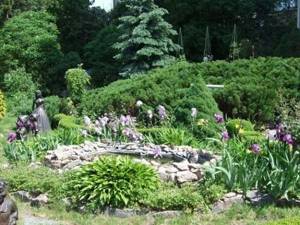
Correct planting of plants in height relative to the cardinal directions
Landscaping a dacha or the yard of a private house requires knowledge of what degree of illumination a particular type of plant prefers. There are always more and less shaded places. There is always more shade from buildings on the north side. Here you need to plant shade-tolerant trees, shrubs, and flowers. Already at a distance of two to three meters, the area may have good illumination, since the shadow from the house may no longer reach there. Here you will need plants that love an abundance of light.
Create a plan for the location of zones and buildings taking into account these rules. There are many more, but even if you take these three into account, your design will be competent, and, what is important, beautiful and harmonious.
Layout
When planning landscape design, it is important to consider a number of very important factors:
- Terrain. Modern designers are able to play with any surface irregularities and make them part of the composition.
- Soil type. This parameter determines which plants will be planted on the site.
- Sides of the world. All zones on the site should be located taking into account the cardinal directions, wind rose and other climatic characteristics. This will allow you to choose the ideal place to relax, hidden from drafts, precipitation and sunlight.
- Land area. The more square meters, the more opportunities to create a unique design with different zones.
- Stylistic preferences. The site must be decorated in the same style, so the choice of stylistic direction must be approached with all responsibility.
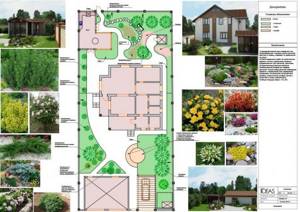
Landscape design project
Plot size
The ability to competently plan landscape design can turn even the smallest plot into a real masterpiece.
6 acres
This area is enough for a whole family to live comfortably. In order to save square meters, it is recommended to use vertical space.

10 acres
On such a site you can place outbuildings, gazebos, a patio, a swimming pool, and arrange a garden.

More than 12 acres
A plot of such area allows you to realize any fantasies - a cozy orchard, a swimming pool, a sports ground, place several residential buildings and outbuildings, lay out many garden paths.

Important! You should carefully choose plants on the site. Tall trees are recommended to be used only in large areas.
Visual expansion of the site
Not everyone can boast of a large plot. But experienced designers can make the most of even a minimal amount of square meters. There are also some tricks with which you can visually make the space more voluminous:
- well-groomed, smooth lawn;
- winding paths;
- competent zoning;
- linear perspective - the closer to the house, the lower the height of the plants;
- vertical gardening - instead of horizontal flower beds, it is necessary to use a vertical plane.
Landscape design elements
Briefly about how you can decorate your dacha, yard, or garden plot. There are many elements, and even more varieties. One of the favorite types of recreation is barbecue or barbecue. And a place must be allocated for this zone. Immediately after determining the location for the house, they often decide where to put a gazebo, terrace, or pergola.
Moreover, the presence of a veranda near the house has never been the reason why a gazebo or terrace was abandoned. In this case, the veranda is made closed, and the gazebo is made open. They spend time in one in winter, in the other in summer. Sometimes a canopy or a modern pergola is installed instead. Not the one that only supports the plants, although there may be such, but the structure through which the plants climb. After all, such a structure is one of the best decorations of the site.
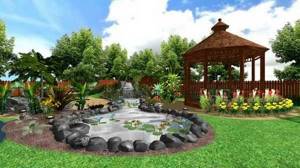
A gazebo and a pond are the favorite and most striking ways to decorate a summer cottage or suburban area.
An equally popular element of landscape design is artificial ponds. They are also made in dachas, gardens, and courtyards. Shape, size, type of organization - everything can be different: from mini ponds to quite respectable ponds with several cubic meters in volume and a decent water surface.
A favorite technique of many designers is to make a stream. Ideally, if there is a spring or a natural stream, but if not, it can be organized. This is not difficult if you have a pond into which water will be supplied. From it a stream can run into the garden or garden. This is both beautiful and practical: your irrigation system will be a design element, and not pipes that have to be hidden somehow. This idea is especially easy to implement on slopes. Even if it is small - only a few degrees, you can take advantage of the natural relief. Read about how to make a waterfall on your property here.
By the way, a vegetable garden can also be decorative, and it doesn’t have to be hidden at all. True, greenhouses still will not decorate the site, but they can be placed behind the trees.

A stream - natural or artificial - looks very beautiful
Between these and other buildings and zones, places are planned for flower beds, flower beds, alpine slides, rockeries, rock gardens, etc. Their shape, size, type of fencing, species composition of plants and their planting scheme are determined. It is clear that without experience it is not easy to do this and there will be a lot of rework, but it is important to start somewhere. Changes to plantings are made almost constantly, so you will be creating landscape design with your own hands for more than one year, or even three: after all, you will also use perennials, and they grow slowly.
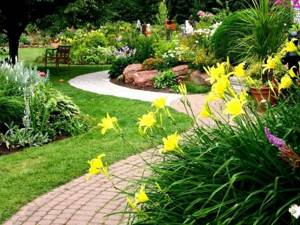
Flower beds, flower beds, borders, rockeries, slides and garden paths - that's what else can be used for decoration
Paths must be laid between all areas and buildings. Their design not least shapes the appearance of the garden or dacha. And in general, landscape design is created largely from little things. Somewhere there is a small bench, somewhere a garden sculpture, a rocking chair, a flowerpot with flowers, a rock garden, a pond, a hanging hammock, beautiful lighting, area lighting, etc. And all this in general is design design.
Thematic approach to landscape design
One of the easiest ways to achieve cohesion in a design is to create a themed landscape design. One of the easiest ways to create a theme is to use garden architecture. Creating a garden theme (there are many different landscaping themes) goes much easier if it somehow intersects with your hobbies or what you love.
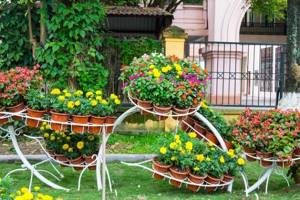
For example, if you love butterflies, then you can create a landscape theme using plants (flowers) that attract butterflies, and also use statues, ornaments and other decor reminiscent of butterflies.
A unified concept should be reflected in at least one element of the landscape, but it is desirable that there be more such elements. Using elements that highlight a particular design style or theme is what creates a cohesive concept for your landscape design.
Plot with a slope
On the one hand, the landscape design of a site with complex terrain is technically more complex: there are more engineering structures, and the terrain needs to be taken into account. But on the other hand, it will definitely look non-standard, since all solutions are individual.
With a fairly large slope, the principle of terrace design is used. The slope is divided into zones, on the low side of which retaining walls are installed. Thanks to them, the surface in a certain area - up to the next wall - is leveled. This occurs due to the fact that part of the soil is transferred.
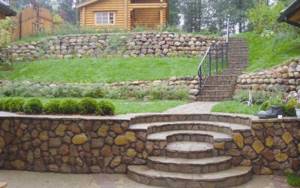
Leveling a slope using retaining walls
The terraces themselves are unusual, but they can also be decorated beautifully. For example, make the masonry from rubble stone, and plant creeping and low-growing plants in the gaps, and plant lawn grass. They will decorate the wall and also hold the soil together with roots.
Technical points
The height of retaining walls is usually no more than a meter, maximum 1.2 m. They are erected from monolithic reinforced concrete, topped with stone, and embankments are made. A foundation is required for each such wall. Usually - reinforced tape. With a wall height of up to 60 cm, a compacted crushed stone cushion with a depth of 20 cm is sufficient as a support; with a wall height of 70 cm, the foundation must have a depth of at least 60 cm; with a height of 1 to 1.2 meters, the depth of the foundation should be at least 70 cm.
Based on the requirements for foundations, the lowest cost for installing retaining walls is with a height of up to 60 cm. If the slope is not very steep, try to divide the slope into sections with such a height difference. And keep in mind that rectangular terraces, although easier to make, from a design point of view, are the worst option, which is almost impossible to make harmonious. See the photo gallery for examples of terracing and decoration.

Masonry without mortar of large stones looks great
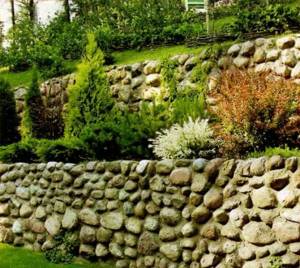
Steep site - short terraces
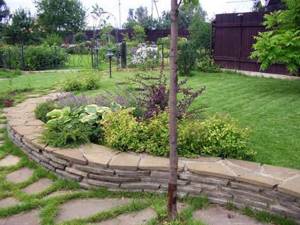
For a small difference, the wall may have unequal height
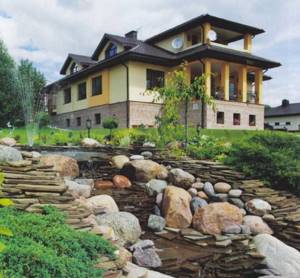
Using a slope to create a stream and waterfalls is a classic technique that remains relevant

Option for how to design a slope in front of the house

Explicit division into two levels - technically difficult, but aesthetically interesting
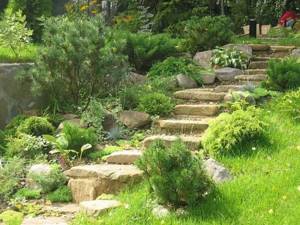
On a small slope, planting plants may be sufficient, if you are, of course, happy with a garden on a slope

If the house and site are decorated in a simple style, then the retaining wall is finished with appropriate materials

Decoration with rubble stone
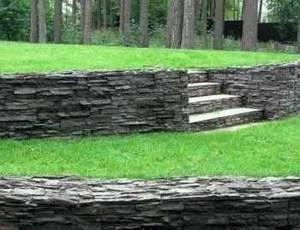
Decorating a retaining wall with torn stone
What is landscape architecture
Landscape architecture is a type of spatial art that deals with the transformation of space through competent planning of the territory and its landscaping. The main goal of the area is to combine natural and building components into one single composition that will have an artistic image.
When creating it, the requirements of convenience and functionality must be taken into account. Each project is developed taking into account the characteristics of the area. The architect’s task is to play with existing species characteristics, take into account the features of the relief, and find a visual solution that will highlight the advantages of the site and hide its shortcomings, without violating technical requirements and restrictions.
Creating a project is impossible without analyzing the composition of the soil and its moisture content. One of the principles for implementing ready-made projects is the seasonality of plant flowering. From early spring to late autumn, any object being renovated must have a well-groomed appearance (elegant and fragrant).
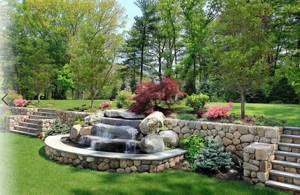
A technique that helps to beautifully beat uneven terrain Source www.bostondesignguide.com
Modern landscape architecture has many tools in its arsenal to do this. All of them can be divided into several groups. Experts highlight:
- Central buildings available on this particular site (this could be a palace, a mansion or a country house).
- Relief – flat planes , hilly terrain , forest area , mountains , ponds , terraces .
- Green spaces (giant trees, shrubs, flowers).
- Parterre or decorative lawns .
- Flower beds , flower beds , rockeries , rosettes , mixbords .
- Architectural groups (fountains).
- Sculpture.
- Lighting.

Designers designing the territory entrusted to them can use all groups of landscape architecture or use a combination of individual types. Each of them has its own purpose. For example, the architecture of the central building determines the style of landscape gardening. If there is a palace in a classical style, the improvement of the area around it can only be carried out taking into account the principles of a regular park. Everything that surrounds the central structure should be a natural continuation of its design. It is in this way that all architectural and artistic compositions are built.
The palace style can be implemented on large, flat areas, but if the terrain suggests large differences in elevation, they are played up by creating cascades of water running from a classical fountain. If necessary, the terrain of the territory can change: the area can be leveled or, conversely, additional obstacles can be created in the form of slides or embankments. Such steps are justified if a single artistic composition requires it.
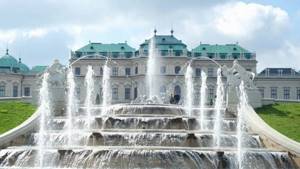
Cascades of water in front of the palace hide the sharp difference in heights in front of the central building - the palace Source www.1zoom.me
When landscaping, the choice of plants is carried out taking into account full compatibility with each other and taking into account the natural soil composition. Compositions of living plants can be infinitely varied, but their location, quantity, and group formation are taken into account at the design stage. The designer preliminarily draws up seating plans and creates three-dimensional 3-dimensional layouts that allow a visual assessment of the future appearance of the landscape gardening. This is the only way to achieve order and the absence of house.
Living plants are the element that helps create the texture of the garden. It can be created using tiered gardening and laying out picturesque flower beds. Plants help cover unsightly places and highlight the advantages of the site. Therefore, this attribute of landscape architecture is used very widely and very willingly.
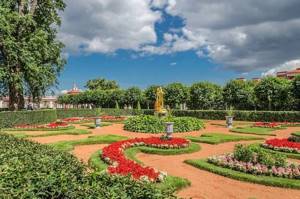
Planting as part of landscape architecture Source triip.me
Green lawns
Lawns, today you can’t live without them. There are several varieties of them, each with its own decorative purpose.
- The ground lawn is a real work of art, a beautiful velvet-emerald background that can highlight the beauty of the design of the house and garden. It makes its shape softer, connects its individual zones, and helps create a sense of integrity. don’t walk on the ground lawn ; they admire it from the side.
- Decorative lawn is a more democratic option for landscaping. It is created if there is a desire to create a green lawn on which you can have picnics . Its surface is resistant to trampling, the decorative lawn is unpretentious and much easier to care for. The green carpet looks very attractive , which is why it is actively used for landscaping large park areas .
- Special lawn coverings - they are used for strictly defined purposes (for arranging shady courts, golf courses, football) There are grass mixtures, the cultivation of which helps to restrain the spread of soil from hillsides. Such lawns have a powerful root system .
- Constantly blooming elegant lawns . The Moorish lawn is similar to a wild flower meadow, but its formation is under strict control.
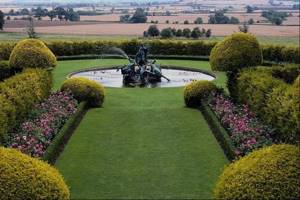
See also: Catalog of companies that specialize in landscape design of sites.
Reservoirs
Reservoirs play an important role in landscape architecture. They enliven the space around them, making landscapes more diverse, complex and interesting. Similar components can be formed using ponds and streams, waterfalls and pools with fountains, canals, cascades and grottoes. Adding moisture-loving plants or accessories, as well as lighting, helps emphasize the chosen thematic direction.
Architectural groups and sculptures
These include separately constructed compositions that are combined with other elements of landscape design. Gazebos, pergolas, arches, artificially created ruins, pedestals - any small groups should be visually attractive. Their equipment must be justified in terms of the chosen style.

Ruins as part of artistic landscaping Source arxip.com
Garden design for a small plot
If the yard near the house or cottage is small, and even of the correct shape - square or rectangular - the fence is most likely visible from anywhere. It feels like being in a box. You can eliminate it by covering the fence with plantings. But they should not grow in a line that follows the shape of the fence, but in smooth, curved curves or groups that extend onto the lawn. Plants can be interspersed with shrubs, rose gardens, you can put a corner gazebo or highlight some area that violates the correctness of the lines.
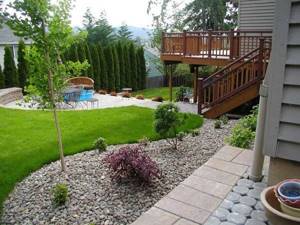
Covering the fence with tall trees is a good idea, but it is better to plant them in groups and of different types
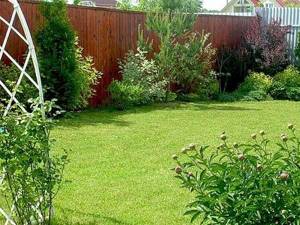
The trees will grow a little and the area will seem wider
Another option to turn the fence into a decorative element: allow climbing plants to turn it into a green wall, and plant low plants with rounded crowns nearby. If the plants will climb along supporting structures, it is better to make their tops non-linear. This way everything will look even better.
Another option is a hedge. It, of course, takes a long time to grow, although fast-growing plants can be used, in particular, for a quick effect for several years, use willow. You can weave a fence from its young branches, but it almost always takes root, sprouts roots and turns green in just a few days.
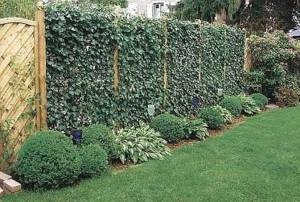
Such a wall is much more decorative than even the most beautiful fence
When decorating a small space, straight paths are strictly prohibited. They make objects optically closer, which is of no use to us at all.
Multi-level planning greatly expands the boundaries. This is the case when a slope is preferable: 6 acres look like a larger plot if there is a difference in elevation. If the dacha or yard is small and flat, you will have to do zoning artificially. Alpine slides and raised flower beds and flower beds will help with this.
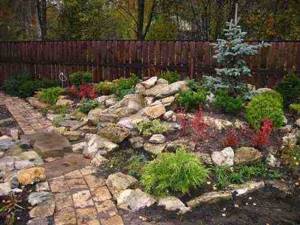
Raised flower beds, rockeries and slides will help visually expand the space
There are some restrictions when landscaping. Do not plant trees with large crowns. Not only will they shade almost your entire area over time, but it will also appear even smaller. Small trees, shrubs and flowers are what you need to choose from. If you need several tall plantings, choose one with a pyramidal crown or in the form of a candle. They are unusual for us, and look very good.
The role of color in landscape design
Color will add a sense of reality and make the landscape interesting. Bright colors of red, yellow and orange attract the eye and create the illusion of proximity to the subject. Cool colors such as green, blue and pastels make the subject stand out.

Black, gray and white are considered neutral colors and work best with bright colors in the foreground. In case you want to add depth to the landscape, use dark plants with textured leaves in the foreground and plants with light shade in the background.
Color can also be used to attract attention to a particular area of your garden. Bright colors among cool shades naturally attract the attention of the eye.
This may be best illustrated in terms of plant height or color, but can also be applied to all elements in the landscape including, but not limited to, the texture, size and shape of foliage and various elements. In other words, the transition can be achieved gradually, rising or falling, by combining different elements with varying structures, shapes, colors, or sizes.
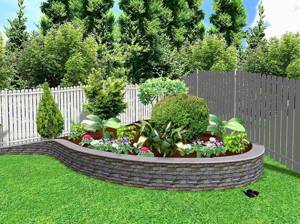
An example of a good transition would be the step-step effect from large trees to medium trees to clumps of ornamental plants. This example illustrates that a little knowledge goes a long way to selecting plants appropriately.
DIY landscape design: photo and video ideas
Theoretical knowledge is great, but if you lack experience, you need to rely on something. Sometimes the impetus for decorating a wonderful corner in the yard in front of the house can be the shape of a bench you like, and plants are already “attached” to it. Some interesting details that may inspire you are collected in photo galleries.
Flowers in decoration
Home entrance design
Cozy places
And finally, ideas in video format


